People
February 8, 2010
First Person: A doctor's aftershocks on return from Haiti
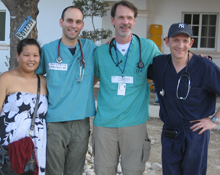
Emory emergency medicine resident Mark Fenig (pictured second from left) travelled with a team of doctors and nurses to help with the Haitian relief effort.
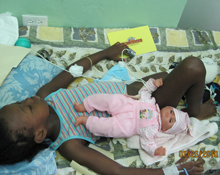
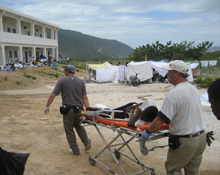
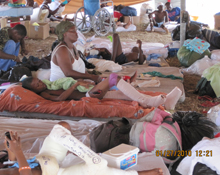
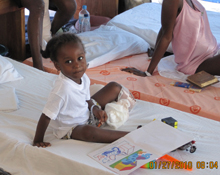
In the aftermath of the Haiti earthquake, Emory emergency medicine resident Mark Fenig joined a relief effort out of Baton Rouge and spent Jan. 25–28 at a hospital compound in Jimani, a city in the Dominican Republic just over the Haitian border. He shares an account of his time there:
The compound was surrounded by bucolic, rolling green hills and a stunning lake. Hundreds of Haitians, some unable to walk due to their injuries, traveled or were carried illegally across the border into our hospital. Most had sustained some sort of orthopedic injury and infectious complications from amputations, inserted pins and crush injuries. Patients slept on bare mattresses in hallways and in the open air.
The reality was, all of the buildings — the hospital, a chapel and an orphanage — were just empty, large structures. Dozens of volunteer medical teams from all over the United States arrived carrying supplies. The hospital had six functioning “operating rooms” and the chapel and orphanage were converted to inpatient wards.
But there were no ventilators so surgeries were performed under regional or spinal anesthesia. There weren’t monitors available so anesthesiologists had to literally keep their finger on the patients’ pulse.
There was no X-ray machine. That meant over 200 people with broken limbs were basically in a holding pattern because they could not receive the treatment they needed, which in most cases, consisted of placing rods inside their broken bones. Instead, their wounds were stabilized with external fixation devices, pins drilled into bones and held together with metal rods outside the body. It was discouraging to see patients lying about with tons of tinker-toy looking hardware sticking out of their arms and legs.
One of my patients was a very sweet 6-year-old who had been trapped under a collapsed house for two days. Her mother and sibling had been crushed to death. The little girl had nothing more than a bruise on her leg and I discharged her with some ibuprofen. I found it ironic that she might have been among the luckiest patients I had seen.
Post-traumatic stress disorder was something the entire cohort of patients shared. There were two aftershocks, one before I got there that resulted in a small tent community of patients who refused to return to an indoor structure. I hardly felt anything during the second aftershock but before I knew it, those who could walk ran or hobbled outside and fell to the grass. Those who could not walk were dragged outside by family members. I will never forget their eyes. It was my first introduction to true terror.
The Haitian patients were the bravest and most stoic group of people I had ever met. They were also the most grateful and helpful. Family members volunteered to help translate Creole or physically transport patients. They would constantly clean up the grounds to keep the compound as germ-free as possible. They would divide their time between their relatives and patients with no family.
There was a small cluster of three orphaned children in my inpatient ward. One had his arm amputated just below the shoulder and the other two had bad fractures with extensive hardware sticking out of their legs. They were surrounded by donated stuffed animals. The first thing I noticed was how they never made noise, cried, or asked for anything. I became increasingly aware of how unnatural this picture looked. By the time I left I realized that the stuffed animals were these children’s new family.
More than anything, I wish I was back there. At times, when I’m not distracted, I find myself thinking about those stuffed animals. Or about what a 6-year-old in a foreign country without a home, a family or an arm has to live for.
These thoughts haunt the volunteers who are parents even more. Kathy, a nurse and mother of two, gave all her cash away to a child before leaving.
I will never forget what I learned over there and I’m still sorting out how to do that in a healthy way. It’s a work in progress.
